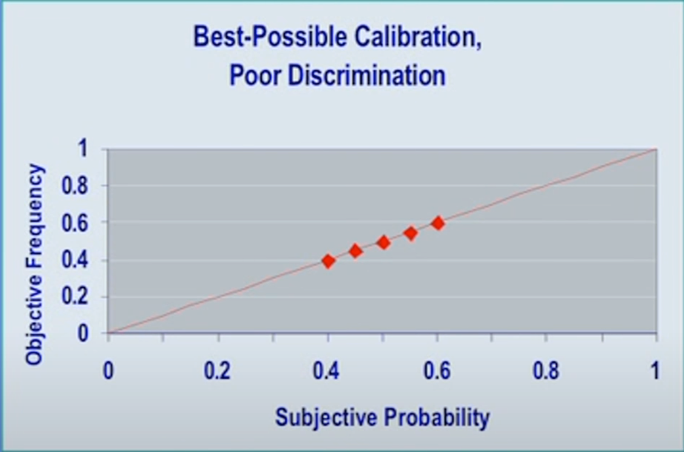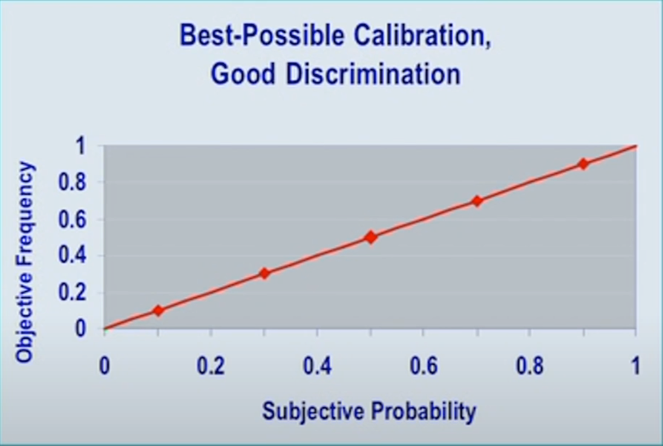The ancient Greek poet Archilochus wrote that “the fox knows many things, but the hedgehog knows one big thing.” In social psychology, these terms have been used as a shorthand for describing two cognitive styles: foxes, who are comfortable with nuance, can live with contradictions, and have different strategies for solving different problems, and hedgehogs, who focus on the big picture, reduce every problem to one organizing principle, and solve problems through that singular lens.
What Makes a Good Decision Maker?
We can start to break down decision making by first understanding what it means to make an accurate prediction. In his talk, Why Foxes Are Better Forecasters Than Hedgehogs, psychologist Phil Tetlock measures the quality of decisions along two dimensions: calibration and discrimination.
- Calibration
- The ability to assign subjective probabilities (predictions or decisions) to outcomes that correspond to their objective probabilities (what actually happened). For example, the weather report is well calibrated if, when they say there is a 70% chance of rain, rain falls 70% of the time.
- Discrimination
- The ability to assign sharply higher probabilities (predictions or decisions) to outcomes that actually happen than to those that do not. For example, if you say with 100% confidence that something will happen, your prediction has high discrimination if it is true.
A perfect decision maker would have a calibration score of 0, because there is no difference between the predictions and the actual outcomes. They would have a discrimination score of 100 because the decision maker is always supremely confident in their predictions.
As an example, consider the “Cowardly Expert”. This is someone who has excellent calibration, meaning there predictions are usually accurate, but they only provide predictions in a small range around 50%, meaning they have low discrimination.

Now, consider someone with excellent calibration and much wider discrimination. This person makes accurate predictions, but they are more likely to assign high probabilities to their predictions.

The last figure shows a perfect decision maker — they make accurate predictions every time and they choose those predictions with either 100% or 0% confidence. In this case, everything this person predicts comes true. Essentially this is omniscience.

With a way to grade decisions in hand, Tetlock and his team enlisted 284 political experts over an 18 year period and had them make 28,000 forecasts which were then graded for calibration and discrimination. The result? Foxes beat hedgehogs every time.
Foxes and Hedgehogs
The Hedgehog and the Fox is an essay by philosopher Isaiah Berlin that built off of the ancient Greek saying that “the fox knows many things, but the hedgehog knows one big thing.”
In this essay, the canonical hedgehog “relates everything to a single central vision, … in terms of which all they say has significance”. The choice of philosophy or belief of a hedgehog doesn’t matter. The important thing is that a hedgehog approaches history and current events in a deductive frame of mind beginning from their core belief. They begin with an organizing principle or framework and try as hard as they can to absorb as many different new facts into their existing framework.
The canonical fox, on the other hand, “pursues many ends, often unrelated and even contradictory, … entertains ideas … without seeking to fit them into, or exclude them from, any one all-embracing inner vision.” Foxes pick and choose from multiple different theories and embrace the uncertainty of the world and of their understanding of it.
Over the 28,000 forecasts made in Tetlock’s study foxes making decisions outperformed hedgehogs in both calibration and discrimination every time. In short, foxes make better decisions. The somewhat contrarian and self-critical style of a fox translates into better decision making.
Although the results show that foxes make better decisions, hedgehogs have value too. Hedgehogs latch on to big ideas and new ways of thinking and they can actually be better at predicting large, sweeping changes, black swan events, and are often early adopters of new ideas. The price of the success of predicting these big changes is that hedgehogs also make a lot of incorrect decisions because they are assigning high probabilities to unlikely events because they match their preconceived belief system.
This is where foxes can leverage the work done by hedgehogs as a complementary force. Foxes take the grand ideas espoused by hedgehogs and combine them with each other, scrutinize them, rule out the false positives, and ultimately make better decisions.
